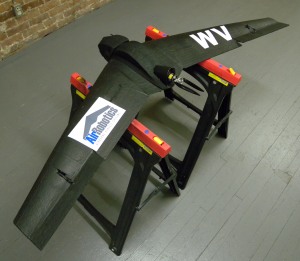Ten years ago, Jeff Imel never imagined that his hobby – building model aeroplanes – would become a full-time occupation. Today, AirRobotics is carving out a niche for its indestructible UAS in the coal-mining areas of West Virginia.
With no vertical surfaces and its matt-black paint job, it looks somewhat like a miniature stealth bomber and even has a U.S. Patent Office Design Patent for its Blended-Wing Body Aircraft. It has a 6-foot wingspan and weighs only 2.5 pounds. A payload pod sits below the wings, which can store different types of equipment weighing up to 15 pounds.
It can carry many different kinds of cameras and sensors – whatever it takes to construct a three-dimensional map of the terrain below or search for chemicals on the ground. The aircraft also has unique endurance. “We discovered it could carry three times more payload than a normal UAS and fly four times longer,” Imel said.
The original plan was to market it to the military as a carrier of nuclear, biological and chemical sensors – Imel had worked on cruise missile guidance for a few years. But he realised that sensors could detect selenium leaks which were a particularly contentious issue between the coal industry and the U.S. Environmental Protection Agency in West Virginia. Selenium is a chemical that occurs naturally in the earth but can be toxic in high concentrations. When the earth is disturbed by heavy industry, selenium is released and bleeds into the water supply.
“This is a game-changer for the coal industry,” Imel said. “Before they really did not know where the selenium was coming from. You look at the ground from the air, and you can’t see the pollution. Up until now they had to do spot testing.” Imel said curtailing the selenium “may be as simple as planting some vegetation or contouring the earth.” But to do so, the industry must know precisely where the selenium leak is. “With our camera you can see exactly where it’s coming from,” he said. “Our technology allows companies to keep their existing permits and allows them to get more permits by verifying they’re protecting the streams.”
One of the UAV’s most fascinating features is its durability. “I determined along the way it needed to be built out of material that was indestructible,” said Imel. “Most customers will be flying in areas where there are no runways. They live a really rough life. They have to be able to survive.”
Imel selected special foam to serve this purpose. He also invented a lacquer that maintains the foam’s shape. “We came up with a process to increase the strength of the weight, but still maintain its crushability,” he said. “We’re the only UAS you could run over with a truck and still not break it.”
Source: The Charleston Daily Mail

